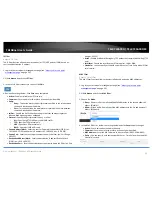
© Copyright 2017 TRENDnet. All Rights Reserved.
TRENDnet User’s Guide
TEW-740APBO / TEW-740APBO2K
48
is weak. While the No ACK policy helps improve transmission efficiency, it can
cause increased packet loss when communication quality deteriorates. This is
because when this policy is used, a sender does not retransmit packets that have
not been received by the recipient. When the Normal ACK policy is used, the
recipient acknowledges each received unicast packet.
WMM Parameters of Station: This affects traffic flowing from the client station to
the access point.
o
Aifsn: The Arbitration Inter-Frame Spacing Number specifies a wait time (in
milliseconds) for data frames
o
CWmin: Minimum Contention Window. This parameter is input to the algorithm
that determines the initial random backoff wait time ("window") for retry of a
transmission. The value specified here in the Minimum Contention Window is the
upper limit (in milliseconds) of a range from which the initial random backoff wait
time is determined.
o
CWmax: Maximum Contention Window. The value specified here in the
Maximum Contention Window is the upper limit (in milliseconds) for the doubling
of the random backoff value. This doubling continues until either the data frame
is sent or the Maximum Contention Window size is reached. Once the Maximum
Contention Window size is reached, retries will continue until a maximum
number of retries allowed is reached. Valid values for the "cwmax" are 1, 3, 7, 15,
31, 63, 127, 255, 511, or 1024. The value for "cwmax" must be higher than the
value for "cwmin".
o
Txop: Transmission Opportunity is an interval of time when a WME AP has the
right to initiate transmissions onto the wireless medium (WM). This value
specifies (in milliseconds) the Transmission Opportunity (Txop) for AP; that is, the
interval of time when the WMM AP has the right to initiate transmissions on the
wireless network.
o
ACM: Admission Control Mandatory, ACM only takes effect on AC_VI and AC_VO.
When you do not click Checkbox, it means that the ACM is controlled by the
connecting AP. If you click Checkbox, it means that the Client is in charge.
Click Save button to save your changes. Click Reboot button to activate your changes.
The items in this page are for AP's RF advanced settings and will be applied to all VAPs
and WDS Links.
WDS (Wireless Distribution System)
Wireless > WDS Setup
When in AP (Access Point) mode, you can also configure the access point to establish
wireless WDS bridged links at the same time (AP + WDS mode).
1. Log into your access point management page (see “
Access your access point
management page
” on page 28).
2. Click Wireless and click on WDS Setup.
3. Review the settings, click Save when finished.
WDS Setup – Enable or Disable WDS functionality.
ESSID – The SSID or wireless network name for WDS connections only.
Authentication – Specifies the type of security used for the WDS link. None or
AES. Please note this is not the same as WPA/WPA2 and can only be used for
WDS connections to this access, not standard wireless client devices.
Summary of Contents for TEW-740APBO
Page 1: ...TRENDnet User s Guide Cover Page ...
Page 93: ......
















































